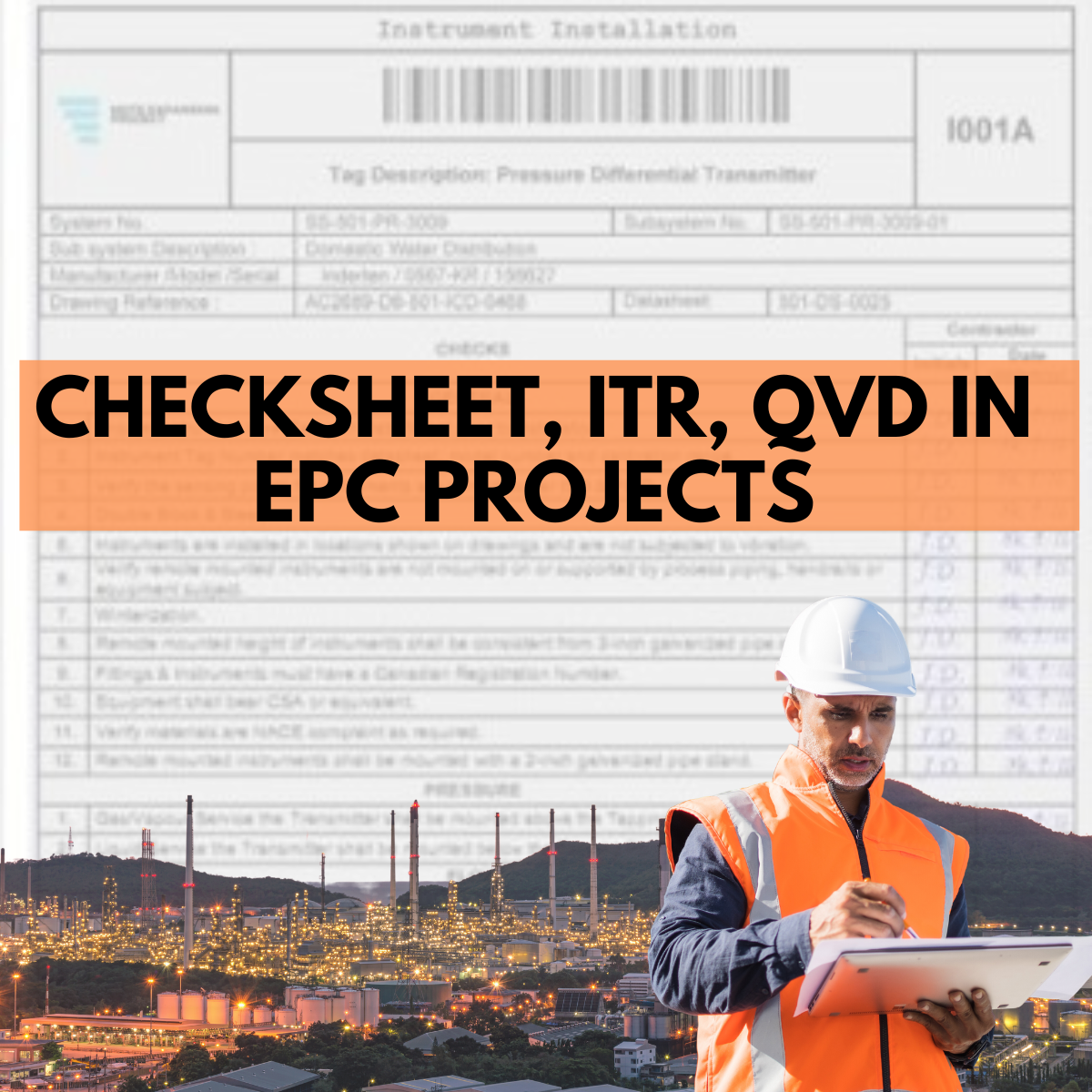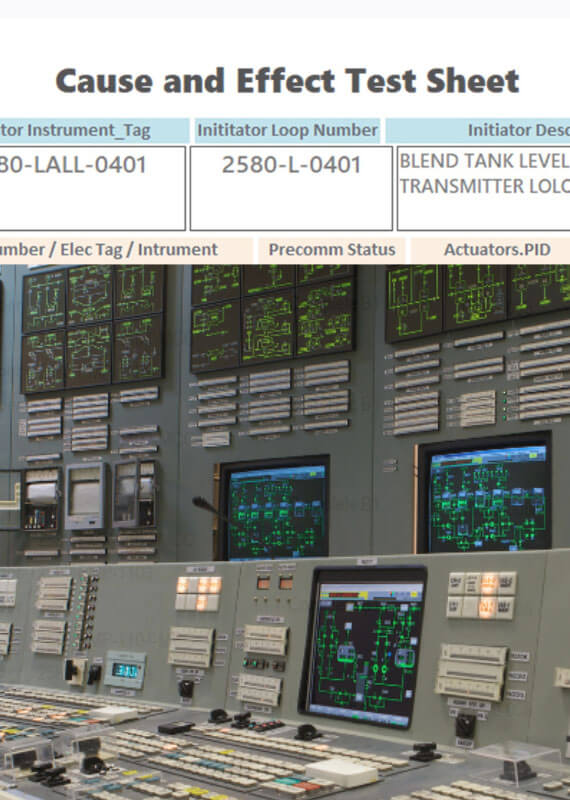I’m Eric Ocampo
SPECIALTIES
System completions
and turnover
System Completions refers to the process of ensuring that all components of a project have been properly designed, developed, tested, and integrated to meet the project requirements and specifications. In EPC projects this includes all hardware, software, and other supporting systems necessary for the project’s success.
System Turnover refers to the process of transferring custody and/or ownership of a system or subsystem (or a defined scope) from the EPC contractor to the project owner across the different defined phases. The turnover process normally follows a structured and systematic approach to ensure that all the necessary activities are completed and that the system or subsystem is thoroughly tested before it is handed over to the project owner.
While Completions is focused on the completeness granularity, Turnover is focused on the transfer of custody.
Related post-articles I’ve published:
is your project completions “spreadsheet-tracking” a scrambled process?
A “master system register” as a powerful tool in epcc projects
Effective management of “subsystem final walkdowns” in epc projects
Effective 1.1: turnover package dossier administration system
Punchlist Management
Punchlist management refers to the process of identifying deficiencies and managing its corrective actions.
The deficiencies may include incomplete or defective work, safety hazards, missing or damaged equipment, or other issues that depending on the category need to be addressed before the respective handover gate.
Although every project is different, at least initially, the punchlist management involves creating a comprehensive list of outstanding items during an agreed walkdown (Preconstruction, Subsystem, Final, PSSR, etc.) and a categorization process which is in correlation with the nature of the deficiency and the phase :
A) Highly Critical
B) Critical punch items that do not affect the safety nor the integrity
C) Noncritical punch items, typically beyond the scope of the contract or project.
An effective Punchlist administration
In respect of “Punchlist Data Administration,” the process involves collecting, organizing, documenting, and tracking the deficiencies to ensure that they are closed promptly and efficiently. It is typical for projects to use software tools like completions database systems to streamline the process and improve collaboration between parties.
However, for me, as SCDB, an efficient punchlist management is not only a one-dimension data tracking process but is also about optimizing the punchlist cycle: “Identify- Register-Assign-Fix-Approve.”
During this cycle, team efforts and actions are more assertive using the most effective punchlist information from the software or completions database system used by the project.
Most projects find themselves in situations that require changes during the execution; these changes very likely drive the need for data customization to help visualize, track, make decisions, and/or take actions for the project’s success.
Some examples of the requirements that I have found in my career are:
- The creation of punchlist subcategories A1, A2, etc., for specific scopes and/or exception purposes.
- The development of dynamic punchlist dashboards interactively grouped by milestone, fishbone, or contractor to be used in daily war room meetings to quickly review, discuss, schedule, assign, and distribute-the actions on the fly.
- The ability to quickly visualize, review and schedule the “on-hold-due-to-materials” punchlists with Materials Management Team. This implementation allowed transparency between material orders, punchlists, and completions systems.
- Connecting with the Planning Team to allot and measure manhours to the punchlist clearing process using “jobcards” or “workplans.” This pairing allowed more transparency of the remaining hours in the schedule.
Depending on the software the project uses, some of these requirements need more or less the manipulation of exported datasets.
Spreadsheets will likely fulfill easy data manipulation requirements. Still, more complex ones will significantly benefit from using relational database techniques and coding. However, it is an effort that might represent a challenge and an improvement opportunity for the project.
As a Completions and Turnover Database Lead, I always encourage my team in using a more effective and structured data management approach beyond the spreadsheets and Completions Database software.
Related post-articles I’ve published:
Project deficiencies and punchlist management
2 ways of how projects could benefit more from their punchlist data
5 useful summary reports and 2 charts in EPC projects (completions & turnover)
Effective management of “subsystem final walkdowns” in epc projects.
Mechanical completions
During the mechanical completion process, various activities are performed, including mechanical testing of equipment, piping systems, electrical systems, and instrumentation. The testing process involves verification that equipment and systems are installed correctly, operate as intended, and meet all performance criteria. Any punchlist identified during this phase and categorized as “A” (and “B” if defined by project procedure) have to be corrected.
Turnover interdisciplinary certificates like Discipline Acceptance Certificate (DAC), or Construction Completions Certificates (CCC or SCN) to achieve the Mechanical Completion Certificate (MCCC) either by partial or complete subsystem.
Related post-articles I’ve published:
5 useful summary reports and 2 charts in EPC projects (completions & turnover)
Effective management of “subsystem final walkdowns” in epc projects.
Is your project completions “spreadsheet-tracking” a scrambled process?
A “master system register” as a powerful tool in EPCC projects
Management of Checksheets, ITRs or QVDs
(Construction “A” & Pre-Comissioning “B”)
The terms of Checksheets, ITRs, and QVDs have been used interchangeably depending on the project or company, nonetheless they are an essential tool for ensuring that all necessary inspections and tests are performed and that no important details are missed.
I’ve found some differences that don’t deviate them from their main purpose.
Checksheet is a document that outlines the list specific items that need to be checked during an inspection or test. The list is to be completed with checkmarks in checkboxes “YES”, “No”, “N/A” and “Punchlist” with space for initials.
Inspection and Test Report (ITR) goes a bit further than just checkmarks; it has fields to record values and more spaces to provide other details like readings, sketches and diagrams like for motor alignment.
Quality Verification Document (QVD) is a heavily Quality Assurance document that can either be a checklist of inspections for a component or a record sheet to document the results of a functional test.
Instructions and activities required to perform the inspections are described in the Inspection & Test Plan (ITP) developed by the project QAQC team.
Some examples of the inspections:
- A ITRs.- Construction and Installation
- B ITRs .- Precomissioning
- C ITRs.- Commissioning
Related post-articles I’ve published:
5 useful summary reports and 2 charts in EPC projects (completions & turnover)
Master tag – Drawings – System scoping?
The “tag source register” in EPCC projects
Tagging, systemization, scoping, mapping, and tag validation
Systemization and Scoping
System scoping involves defining and identifying the scope of work for a specific system or subsystem within a larger project. This typically involves breaking down the overall project scope into smaller, more manageable pieces that can be more easily defined, planned, and executed.
A common practice for this activity is highlighting (or colouring) either manually or electronically drawings. Process and Instrumentation Drawing (PIDs) for process equipment like instrument, pipelines, Mechanical, Single Line Drawings (SLD) for Electrical equipment like switchgear, MCC, etc.
Tag Validation
The continuous revision and update of the Engineering lists means a need of a constant validation as it is very likely that there will be some new tags, other might have been deleted or renamed either in the tag itself or in the description.
This proper tag validation is essential to ensure the project is being executed with the most updated data from Engineering.
Related post-articles I’ve published:
The “tag source register” in EPCC projects
A “master system register” as a powerful tool in EPCC projects
Master tag – Drawings – System scoping?
Effective 1.1: turnover package dossier administration system
Project QAQC controls management (RFI, CAR, NCR)
RFI or SQ
Site queries, also known as Site Query (SQ) or Requests for Information (RFIs), are formal communication tools used in Engineering, Procurement, and Construction (EPC) projects to address questions, clarify uncertainties project specifications, or resolve discrepancies that arise during the construction phase of a project.
NCR
NCRs, on the other hand, are formal reports that document instances of non-conformance, or deviations from project requirements, specifications, or industry standards. NCRs are typically issued by quality control personnel or inspectors and are used to identify and document issues with the work being performed.
CAR
A Corrective Action Request (CAR) is a document used in project management to request corrective action to be taken when an issue or problem is identified.
In the context of EPC (Engineering, Procurement, and Construction) projects, CARs may be used to address issues related to the design, procurement, or construction phases of the project.
Although not always, NCR and CAR are in close relationship.
Related post-articles I’ve published:
5 useful summary reports and 2 charts in epc projects (completions & turnover)
Effective management of “subsystem final walkdowns” in EPC projects.
Precomissioning
During pre-commissioning, various checks, tests, and activities are performed to ensure that all components are functioning properly and meet safety and operational requirements.
Unless the project has a Pre-commissioning team, these activities are generally completed by construction prior to Mechanical Completion.
Related post-articles I’ve published:
A “master system register” as a powerful tool in EPCC projects
Effective management of “instrument loop folders” using ms access
Is your project completions “spreadsheet-tracking” a scrambled process?
“Cause and effect” testsheet management application
Instrument Loop pack management
So, before proceeding with the Loop Testing, it is essential to have identified the location, scope, specifications, and readiness of the loop. A common practice in projects is to consolidate the applicable documentation in “Instrument Loop Folders.”
Related post-articles I’ve published:
Effective management of “instrument loop folders” using MS Access
“Cause and effect” testsheet management application
Get efficient, not just busy. Pipeline testing: A Test package dossier management application.
The “tag source register” in EPCC projects
Management of Change (MOC), Site Instructions (SI), Field Construction Notice (FCN)
Management of Change (MOC)
MOC, or Management of Change, is a systematic process for managing and controlling changes to engineering, procurement, and construction (EPC) projects. Changes can occur at any stage of a project and can impact scope, schedule, cost, quality, or safety. Effective management of change is essential to minimize risks, maintain project objectives, and ensure the successful completion of the project.
Site Instructions (SI), Field Construction Notice (FCN)
Site instructions, also known as Field Instructions or Construction Change Directives, are formal written directives issued by the project owner, engineer, or project management team to the construction contractors or subcontractors during the execution of an Engineering, Procurement, and Construction (EPC) project. Site instructions provide clarification, additional information, or changes to the original scope, design, or construction method to ensure that the project is executed according to the project specifications, contract requirements, and industry standards.
Related post-articles I’ve published:
5 useful summary reports and 2 charts in EPC projects (completions & turnover)
Project deficiencies and punchlist management
Pipe Test Pack management
Pipeline testing typically involves a series of tests that are performed to check for leaks, pressure integrity, and overall system functionality. These tests may include hydrostatic testing, pneumatic testing, leak detection testing, service tests and other specialized tests, depending on the specific requirements of the project.
Usually, is the Construction Contractor who group this testing into “TestPacks” with the approval of Engineering and QAQC of the project. These testpack include the pipelines (or portions) and their pressure gauges, temperature sensors, and other testing instruments.
Related post-articles I’ve published:
Get efficient, not just busy. Pipeline testing: A Test package dossier management application.
Effective 1.1: Turnover package dossier administration system
Effective management of “Instrument Loop Folders” using MS Access
2 Ways of how projects could benefit more from their punchlist data
Project walkdown management
Although every project is different, these are some of the most common types of walkdowns:
Contractor (or Construction) Completions Walkdown
For this type of walkdowns, the Contractor is required to initiate a completions walkdown for verification of system completeness at that time (or prior to). The Contractor shall prepare a walkdown package and must present it to the Company at the time of making their completions walkdown notice. Depending of the completeness criteria (i.e. percentage of construction ITRs or manhours) the walkdown invitation is accepted to proceed by the company.
“A” punchlists must be completed before the subsystem completions certificate (SCN) or before the Contractor submit their invoice whichever is the earliest.
Final Completions walkdowns
Final walkdowns are comprehensive and multidisciplinary walkdowns conducted between Construction/Precomissioning and Comissioning teams, sometimes they might include third-party inspection agencies.
The purpose of the final walkdown is to identify any remaining deficiencies, discrepancies, risks or non-conformances that need to be addressed before the project can be formally turned over to Commissioning.
This walkdown serves as a final assessment of a system or sub-system is made based on the status of any new punch list and/or those raised during the prior construction completions walkdowns.
Any “A” and “B” punchlists at this stage should be cleared before the transfer of custody certificate is signed unless exemptions and recategorizations agreed.
PSSR Walkdowns
PSSR walkdowns are conducted to ensure that equipment and systems are ready to be started up safely and that all necessary safety measures are in place before startup. This walkdown is typically conducted after the completion of construction, installation, and pre-commissioning activities but before the actual startup or commissioning of the facility.
During the PSSR walkdown, several parties from Engineering, Safety, Process, Commissioning, Operations and Start-up teams will inspect equipment, systems, and review procedures to ensure that any hazards associated with the startup process have been identified and properly controlled.
Related post-articles I’ve published:
Effective management of “Subsystem Final Walkdowns” in EPC projects.
Effective 1.1: Turnover package dossier administration system
A “Master System Register” as a powerful tool in EPCC projects
Preservation & Maintenance data implementation and management
Once the equipment is put under service, preservation turns into a maintenance process.
Related post-articles I’ve published:
“20,000 Pieces of tagged equipment”: Materials Management DB MS Access application
Project deficiencies and Punchlist Management
Materials Data Tracking Management
In addition to factors such as material availability, lead times, supplier capacity, and transportation logistics, a good strategy should consider an effective and practical communication system to easily order, track, quantify and follow up the materials.
Materials Management team usually interacts with several parties involved in this Materials supply process: Construction, Manufacturers, Warehouse, Logistics, Contractors, etc.
A proper material management execution ensures the materials are being moved safely and efficiently; any delay or setback will very likely impact budget, schedule, or safety record at the worst.
Related post-articles I’ve published:
“20,000 Pieces of tagged equipment”: Materials Management DB MS Access application
Project deficiencies and Punchlist Management
Get efficient, not just busy. Pipeline testing: A Test package dossier management application.
Red Line Data Management
The Red Line Management involves establishing clear procedures for capturing and tracking these changes and ensuring that they are properly documented, reviewed, and approved before being incorporated into the final design.
Related post-articles I’ve published:
Master tag – Drawings – System scoping?
A “Master System Register” as a powerful tool in EPCC projects
System Turnover Package Administration (Dossiers)
STPs serve as the support of the completed scope to be transferred from the construction phase to the commissioning and startup phase of the project. Upon the extent of the table of contents, a properly bookmarked and metadata electronic version of the STP could be a powerful source to track the project history of any specific scope, piece of equipment or pipeline.
Related post-articles I’ve published:
Effective 1.1: Turnover package dossier administration system
Get efficient, not just busy. Pipeline testing: A Test package dossier management application.
Is your project completions “spreadsheet-tracking” a scrambled process?
A “Master System Register” as a powerful tool in EPCC projects
Cause and Effect Matrix management
To achieve this goal, the idea is to group C&E Function test packs with the initiator/actuator test documentation completed to prepare a baseline plan.
The typical approach
The typical approach in most of the projects, is the matrix representation in spreadsheets, where the list of initiators are listed on the frozen columns to the left and the actuators are columns to the right (with some few frozen rows at the top for the tag, description and B checksheet).
The crossings cells of the rows(initiator) vs columns (actuator) are filled with the effect (Cl – Close Valve, OP – Open valve, SD – Shutdown device), etc

















